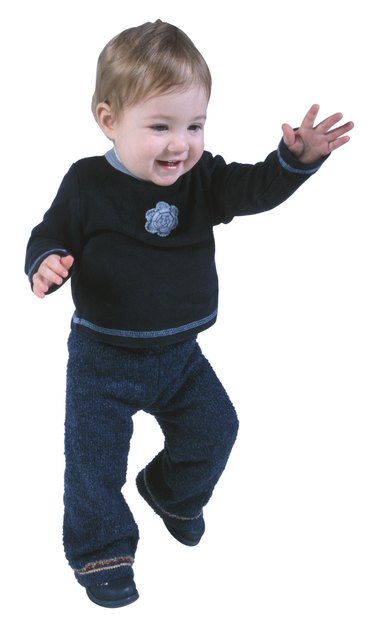
Pigeon-toed feet is a common orthopedic condition in young children. It is also called in-toeing and occurs when the feet turn inward instead of naturally lining up straight. University of Iowa Hospitals and Clinics notes that babies often have a natural in-turning of the legs when they first begin walking at the age of eight to 15 months. This condition usually corrects itself as the hip bones strengthen. However, in some young children, the hip bones remain weak or the shin bones of the lower legs turn in, causing a pigeon-toed walk. Your child's pediatrician may prescribe treatments including physiotherapy. Here are some examples of exercises to correct pigeon toes.
Step 1
Have your toddler or young child sit up straight in a child-size firm chair. Children with pigeon toes tend to naturally sit with their legs crossed. Help your child sit in the chair with her legs uncrossed and feet flat on the floor. Trace her feet in the correct slightly-outward position onto a piece of paper. Make a game of this exercise by having your child sit in the chair with her feet in the outlines of the tracings on the paper. This exercise can be done regularly while the child is eating, coloring or reading. Continue this exercise daily until the condition is corrected.
Video of the Day
Step 2
Clear an area that is approximately 6 square feet in your living room or garden to avoid any injuries. Show your toddler or young child how to walk backward. Have him follow you in the backward walking. Continue the exercise for up to 10 to 20 minutes or as long as he is able to do so. This exercise helps to strengthen the hip joints to keep the feet straight while walking. Repeat this exercise regularly during play and walking time.
Step 3
Make a low walking beam for your child to walk on. Place the board of wood on two square pieces of wood or 2 bricks. Keep the plank only three to five inches above the ground to avoid injury due to falling. Help your child walk across the full length of the plank two to four times a day and continue this exercise regularly until she is walking normally. This exercise helps the child place one foot in front of the other correctly, and strengthens the muscles that keep the hip and shin bones aligned.
Things You'll Need
Child-size firm chair
Paper
Wood approximately 2 by 6 inches wide and 3 feet long
2 bricks
Tip
Your doctor may also recommend a brace that is worn on both feet and keeps them pointing outward. Put this brace on your child's feet every night after he is in bed, as recommended by your doctor.
Warning
Pigeon toes is an orthopedic condition that must be diagnosed by your pediatrician or doctor. Other conditions can also affect the developing gait in children. Exercises for this condition should also be prescribed by your child's doctor or physiotherapist, and performed as instructed.
Video of the Day